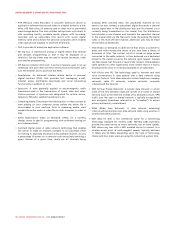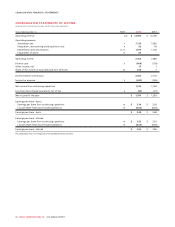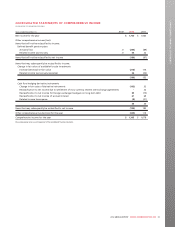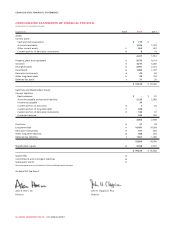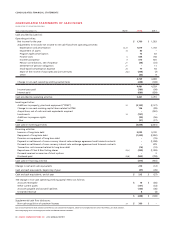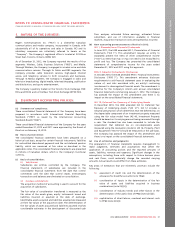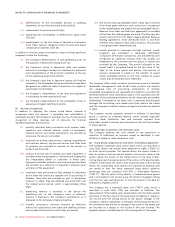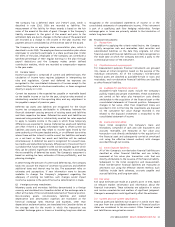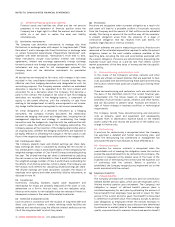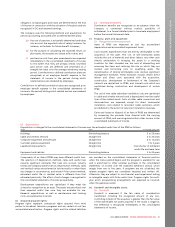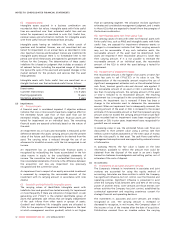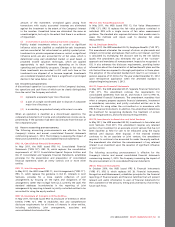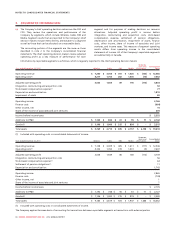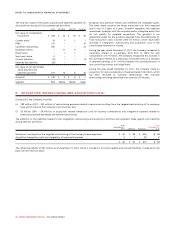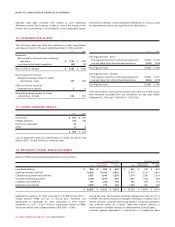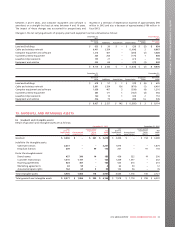Rogers 2012 Annual Report Download - page 93
Download and view the complete annual report
Please find page 93 of the 2012 Rogers annual report below. You can navigate through the pages in the report by either clicking on the pages listed below, or by using the keyword search tool below to find specific information within the annual report.
NOTES TO CONSOLIDATED FINANCIAL STATEMENTS
The Company has a deferred share unit (“DSU”) plan, which is
described in note 23(c). DSUs are recorded as liabilities. The
measurement of the liability for these awards is based on the fair
value of the award at the date of grant. Changes in the Company’s
liability subsequent to the grant of the award and prior to the
settlement date are due to changes in the fair value of the award and
are recorded as a charge to net income in the year incurred. The
payment amount is established as of the exercise date of the award.
The Company has an employee share accumulation plan, which is
described in note 23(d). The employee share accumulation plan allows
employees to voluntarily participate in a share purchase plan. Under
the terms of the plan, employees of the Company can contribute a
specified percentage of their regular earnings to the plan through
payroll deductions and the Company makes certain defined
contribution matches, which are recorded as compensation expense
in the year made.
(i) Income taxes:
Income tax expense is comprised of current and deferred taxes. The
calculation of income taxes requires judgment in interpreting tax
rules and regulations. Current and deferred tax expenses are
recognized in the consolidated statements of income except to the
extent that they relate to a business combination, or items recognized
directly in equity or in OCI.
Current tax expense is the expected tax payable or receivable based
on the taxable income or loss for the year, using tax rates enacted or
substantively enacted at the reporting date, and any adjustment to
tax payable in respect of previous years.
Deferred tax assets and liabilities are recognized for the future
income tax consequences attributable to differences between the
financial statement carrying amounts of existing assets and liabilities
and their respective tax bases. Deferred tax assets and liabilities are
measured using enacted or substantively enacted tax rates expected
to apply to taxable income in the years in which those temporary
differences are expected to reverse. Deferred tax assets and liabilities
are offset if there is a legally enforceable right to offset current tax
liabilities and assets and they relate to income taxes levied by the
same authority on the same taxable entity, or on different tax entities
where these entities intend to settle current tax liabilities and assets
on a net basis or their tax assets and liabilities will be realized
simultaneously. A deferred tax asset is recognized for unused losses,
tax credits and deductible temporary differences to the extent that it
is probable that future taxable income will be available against which
they can be utilized. Significant estimates are required in evaluating
the recoverability of deferred tax assets. The Company’s assessment is
based on existing tax laws, estimates of future profitability, and tax
planning strategies.
In determining the amount of current and deferred tax, the Company
takes into account the impact of uncertain tax positions and whether
additional taxes and interest may be due. The assessment relies on
estimates and assumptions. If new information were to become
available to change the Company’s judgement regarding the
adequacy of existing tax liabilities, such changes would impact
income tax expense in the period that such a determination is made.
(j) Foreign currency translation:
Monetary assets and monetary liabilities denominated in a foreign
currency are translated into Canadian dollars at the exchange rate in
effect at the date of the consolidated statements of financial position.
Non-monetary assets, non-monetary liabilities and related
depreciation and amortization expenses are translated at the
historical exchange rates. Revenue and expenses, other than
depreciation and amortization, are translated into Canadian dollars at
the average rate for the month in which the transaction was
recorded. Exchange gains or losses on translating long-term debt are
recognized in the consolidated statements of income or in the
consolidated statements of comprehensive income, if the instrument
is part of a qualifying cash flow hedging relationship. Foreign
exchange gains or losses are primarily related to the translation of
certain long-term debt.
(k) Financial instruments:
(i) Recognition:
In addition to applying the criteria noted below, the Company
initially recognizes cash and receivables, debt securities and
subordinated liabilities on the date they originate. All other
financial assets and financial liabilities are initially recognized on
the trade date at which the Company becomes a party to the
contractual provision of the instrument.
(ii) Classification and measurement:
For measurement purposes financial instruments are grouped
into classes at initial recognition based on the purpose of the
individual instruments. All of the Company’s non-derivative
financial assets are classified as available-for-sale or loans and
receivables, and non-derivative financial liabilities are classified
as other financial liabilities.
(a) Available-for-sale financial assets:
Available-for-sale financial assets include the Company’s
publicly traded and private investments. These investments
are carried at fair value plus transaction costs directly
attributable to the acquisition of the financial asset on the
consolidated statements of financial position. Subsequent
changes in fair value, other than impairment losses, are
recorded in OCI. At the time the investments are disposed
of, the cumulative fair value change recorded in OCI
related to the disposed investment is reclassified to the
consolidated statement of income.
(b) Loans and receivables:
Upon initial recognition the Company’s loans and
receivables, comprised of cash and cash equivalents and
accounts receivable, are measured at fair value plus
transaction costs directly attributable to the acquisition of
the financial asset and subsequently carried at amortized
cost using the effective interest method, with changes
recorded through net income.
(c) Other financial liabilities:
All of the Company’s non-derivative financial liabilities are
classified as other financial liabilities and are initially
measured at fair value plus transaction costs that are
directly attributable to the issuance of the financial liability.
Subsequent to the initial recognition and measurement,
these non-derivative financial liabilities are measured at
amortized cost using the effective interest method. Such
liabilities include bank advances, accounts payable and
accrued liabilities, and long-term debt.
(iii) Fair value:
Fair value estimates are made at a specific point in time, based
on relevant market information and information about the
financial instruments. These estimates are subjective in nature
and involve uncertainties and matters of significant judgment.
Changes in assumptions could significantly affect the estimates.
(iv) Current and non-current classification:
Financial assets and liabilities due in part or in whole more than
one year from the consolidated statements of financial position
dates are considered to be non-current. Other financial assets
and liabilities are recognized as current.
2012 ANNUAL REPORT ROGERS COMMUNICATIONS INC. 89



